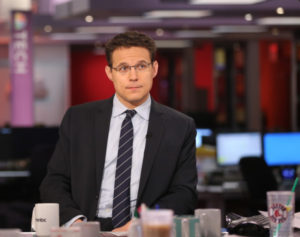By Katherine Coble || News Editor

On Thursday, March 2, MSNBC political correspondent Steve Kornacki came to Franklin & Marshall College to speak about the current political climate in America. Kornacki, 37, is the host of MSNBC’s 4:00 p.m. edition of MSNBC Live and was a leader of their daytime political coverage throughout the 2016 presidential election. Kornacki previously spent several years covering local politics in New Jersey and is the former senior political writer for Salon.com. He will be releasing a book on the political history of the 1990s sometime next year. This event was his first time speaking at Franklin & Marshall and his first time in Lancaster. The talk was extremely well-attended by a mixture of students, faculty, and community members.
The majority of Kornacki’s talk was an analysis of the voting demographics in the 2016 election. Kornacki promised to interpret the statistics and then provide insight into the 2018 midterm and 2020 presidential elections.
Kornacki began by breaking down the difference in voting share for each party by racial category and how these demographics differed from 2012 to 2016. Although Hillary Clinton won the popular vote, the Democrats did not receive as much of the Latino vote as they had anticipated, especially when considering Trump’s extremely hardline stance on immigration — a sharp contrast from the post-2012 Republican platform of “comprehensive immigration reform” and compromise with Democrats on the issue. Kornacki pointed to this as a particularly troubling statistic for the Democrats because America’s Latino population is its fasting growing, and dominating the Latino vote in the way post-1964 Democrats have dominated the African-American vote would be an immense gain for the party.
Kornacki also analyzed the statistics for college-educated whites and non-college-educated whites. Democrats did not get the share of the white college-educated voters that they had hoped; Romney took this demographic by 14 points while Trump took the category by 4 points in 2016. Although this was an improvement, the advantage still went to Republicans overall. Trump also saw significant gains with the non-college-educated white population, including record turnout. Kornacki pointed to the rust belt states like Pennsylvania, Ohio, Michigan, and Wisconsin as the reason for Trump’s Electoral College victory. The passion of non-college-educated white Trump supporters was able to give him a win.
In his analysis of the election results, Kornacki argued that, although much attention was paid to Donald Trump’s uniqueness as a presidential candidate, Hillary Clinton was unique as well. Kornacki said that Clinton had been in the national spotlight for so long that she had some to represent “the system” of government. The people that voted for her, in Kornacki’s opinion, voted for her because that believed that “the system” was working. Those that felt cheated, hurt, or ignored by “the system” may not have been fans of Trump, but they were fans of the system even less, and so they did not want to see Clinton in office.
Kornacki finished his talk by turning to the future of American politics: specifically, the 2018 midterm elections and the 2020 presidential election. He believes that it will be incredibly hard for the Democrats to retake the Senate in 2018 because so many of the seats up for re-election are already held by Democrats and several are in states that went for Trump. They may fair slightly better in taking control of the House, especially if they can convince the college-educated white voters to swing further away from the party of Trump.
In the Q&A session, Kornacki fielded a variety of questions about media, politics, and his experiences covering the election. An engaging and funny speaker, Kornacki’s talk was interspersed with anecdotes of his life on the road talking to voters throughout 2016. Kornacki said he did not necessarily agree with the calls for media to “call out” Trump, because such an attitude only serves to solidify and anger his base. He also expressed doubt about the critique that the media covered Trump too much, arguing that Trump’s campaign was unusually newsworthy and his oft-improved speeches justified airing on cable news. He also doubted that many people watched daytime cable political coverage and were swayed by it.
Kornacki finished the Q&A with a question about how the new generation of journalists should be trained. He said that, while there is a place for journalists to be open about their political views and write from a political perspective, there is also a need for journalists that make an effort to be unbiased. He spoke of the “two bubbles” that Americans currently live in, largely socio-economic bubbles. Particularly since the migration of college-educated white voters away from Trump, journalists in New York City and Washington, D.C. have lost local sources that support the Republican president. Despite this, Kornacki believes that journalists should strive to report in a more neutral manner.
“I think that journalists need to think long and hard about fairness,” Kornacki said as his talk closed out. Only time can tell how the media will actually behave in the Trump presidency.
First-year Katherine Coble is the News Editor. Her email is kcoble@fandm.edu.
